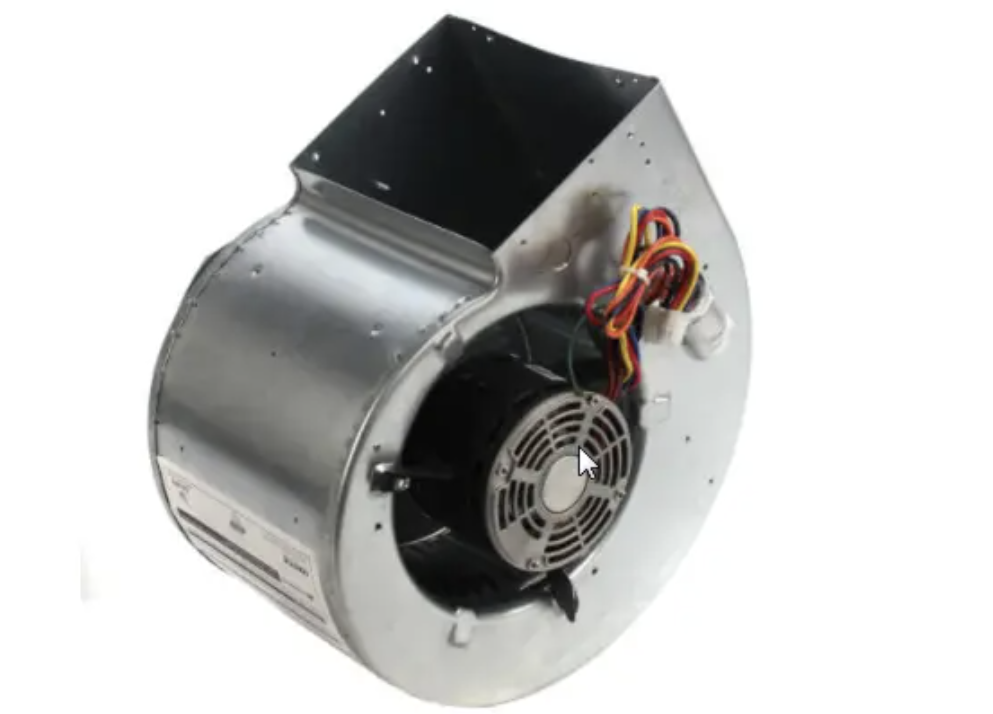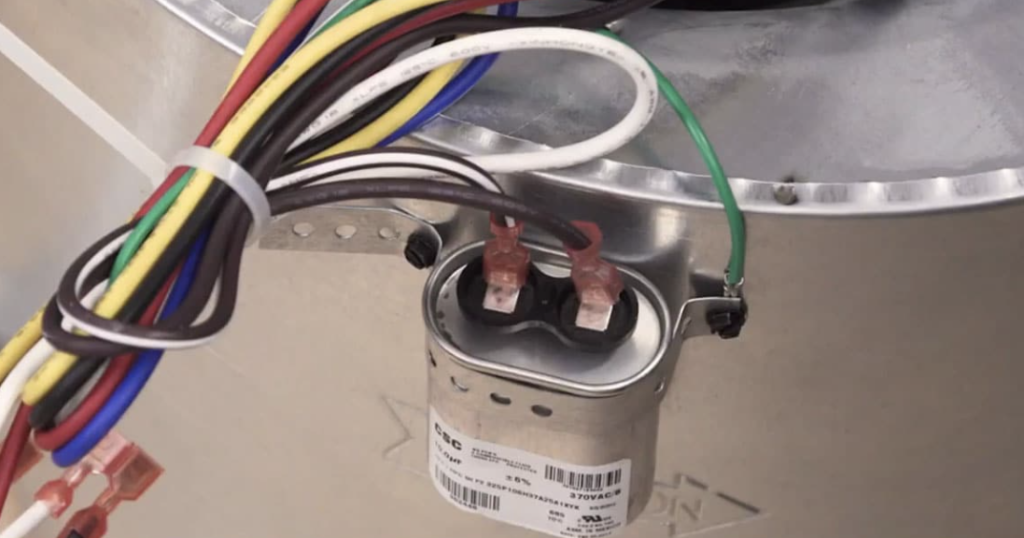Furnace Blower Not Working? Find out why and how to fix it.
Despite having the thermostat set to a cozy temperature, does your house feel a little chilly? Or perhaps you’ve observed an odd silence where your furnace’s soothing hum normally would be? If so, you are not by yourself. An annoying problem that can leave you shivering in the cold is the mystery “Furnace Blower Not Working” situation.

But don’t worry, dear reader; we’re going to set off on a voyage to solve this riddle and bring warmth back into your home.
At a glance: Furnace Blower Not Working due to Tripped Circuit Breaker,Furnace Blower Motor Overload or Furnace Blower Capacitor Symptoms.
Imagine yourself enjoying a cup of hot cocoa on the couch on a chilly winter night when all of a sudden, the heat disappears and the furnace blower turns eerily silent.
Related post>>>>Furnace Gas Valve Not Opening.
The good news is that this problem’s answer is frequently simpler than you might expect. The potential causes of your malfunctioning furnace blower will be thoroughly examined in this post, along with clear explanations and useful advice for resuming the flow of warm air.
So come along with us as we solve the riddles of a “Furnace Blower Not Working” if you’re sick of playing detective in your own house and want to recover your comfortable haven.
You’re close to bringing warmth and comfort back to your living area. Let’s get going!
Causes of Furnace Blower Not Working.
1.Tripped Circuit Breaker.

The agony of a “Furnace Blower Not Working.” When we most yearn for warmth, Mother Nature seems to have chosen this moment to put us to the test.
But worry not—a regular offender known as the “Tripped Circuit Breaker” is one of the puzzle’s icy culprits.
Imagine yourself curled up in your favorite blanket, anticipating the comforting embrace of your furnace’s warm airflow, only to discover that the blower has steadfastly remained inactive.
Let’s investigate the fascinating world of tripped circuit breakers and how they can cause your furnace to shut down completely before you descend into a full-blown winter’s sorrow.
For your electrical system, a circuit breaker functions as an angel of protection. Its responsibility is to safeguard your home from electrical overload, which can be brought on by several appliances operating at once or a short circuit.
The circuit breaker “trips” when it notices an excessive spike in current, effectively cutting off the power to avoid any possible damage or fire risks.
Here’s where things start to get interesting. Your furnace is an energy-hungry beast that needs a lot of electricity to run effectively.
The circuit breaker may decide to step in if your furnace consumes too much electricity or there is an electrical problem for any reason. It’s like the furnace telling you, “I need a break!”
Due to the circuit breaker tripping, your furnace’s power supply is cut off, resulting in the “Furnace Blower Not Working” problem.
The good news is that by recognizing this electrical system oddity, you can save needless anxiety and costly repairs.
Furnace Blower Fan Belt Stretched, Misaligned & Snapped
The “Furnace Blower Not Working” drama continues, and this time the fan belt—a little but crucial part of your furnace’s operation—becomes the elusive culprit.
Imagine that despite your desire for warmth, your furnace is strangely silent. The fan belt may end up becoming the cold story’s unseen hero due to its propensity for straining, misalignment, or even a spectacular snap.
The blower’s performance depends heavily on the fan belt, which can be thought of as the furnace’s heart.
It is in charge of sending energy from the engine to the blower wheel, which produces the airflow that warms your house. But over time, this unassuming belt may succumb to the unrelenting forces of wear and tear.
The fan belt’s first possible naughty deed is stretching. It loses grip and tension, much like an overused elastic band, which results in less effective performance.
Misalignment then occurs as the belt begins to deviate from its intended course, leading to the “Furnace Blower Not Working” scenario.
And in the most shocking turn of events, the belt can suddenly crack, leaving your blower completely silent.
The fan belt’s adventures may sound like a scenario from a fiery thriller, but understanding its function is crucial for identifying the problem.
The fan belt might simply be the unsung hero or the cunning trickster in your quest to restore comfort, so don’t forget to give it a nod the next time your furnace makes you long for warmth.
Also read>>>>Furnace leaking water when ac is on.
2.Furnace Blower Motor Overload.
As we explore the world of the furnace blower motor overload, the mystery of a “Furnace Blower Not Working” assumes yet another turn.
Imagine yourself wrapped in blankets, anticipating the soothing warmth of your furnace, but instead discovering an unsettling silence. What’s causing this frozen situation?
Enter the blower motor in the furnace, frequently an unsung hero but occasionally the cause of our winter angst.
Your heating system’s heart is the furnace blower motor, which spins the blower wheel and distributes warm air throughout your house.
But occasionally, this powerful motor can become exhausted from its own herculean efforts.
When a motor is overworked and subjected to excessive electrical current, overload occurs. Similar to expecting a marathon runner to sprint indefinitely, they will ultimately need to stop and regain their breath.
The furnace blower motor might also trip an internal overload switch or fuse when it reaches its limit, resulting in the dreaded “Furnace Blower Not Working” situation.
Our furnace mystery’s fascinating turn tells us that even the most powerful heroes have their limitations.
Therefore, the next time your furnace blower stops working, keep in mind that a motor overload could be the cause—an unexpected detour in your mission to recapture the warmth in your house.
3.Furnace Blower Capacitor Symptoms.

We now focus on the elusive offender known as the furnace blower capacitor in the ongoing drama of a “Furnace Blower Not Working.”
Imagine yourself on a frigid night eagerly anticipating the warmth that your furnace should offer, but all you get is an unnerving silence. Here comes the furnace blower capacitor, a player who is frequently forgotten but is crucial to this winter drama.
Your blower motor gets the first boost of energy it needs to start spinning from the furnace blower capacitor, which functions like a battery for it.
However, this seemingly innocuous component occasionally exhibits signs that result in the dreaded “Furnace Blower Not Working” scenario.
The symptoms of capacitors can be deceptively modest yet have a significant impact. They could be a gradually decreasing blower performance, irregular starts and stops, or even a total motor failure.
The blower motor hesitates in its warming task, as though the capacitor is whispering to it about its problems.
Understanding these symptoms is essential to solving the puzzle of why your house is so cold. Although the furnace blower capacitor’s function is subtle, its symptoms might reveal a lot about the broader problem at hand.
The following time your furnace makes you desire for warmth, think of the intriguing prospect of a capacitor-related twist as you work to make yourself comfortable again.
Also read>>>>Furnace Turns On But No Heat.
Fixes of Furnace Blower Not Working.
1.Examine The Circuit Breaker.
When faced with the frustrating situation of a “Furnace Blower Not Working,” there are occasions when the answer might be found by looking at the circuit breaker.
While on a chilly winter day, your house is steadfastly chilly even though your furnace is set to offer heat. It’s a circumstance that could make you feel uneasy, but don’t worry—often, the solution is as simple as flicking a switch.
Your home’s defense against electrical overloads and potential dangers is that unassuming panel in your electrical box called a circuit breaker.
When it notices an irregular surge in current, it is built to trip or cut off power, protecting your house from harm or fire.
Now think about this: your furnace is a power-hungry gadget that needs a lot of electricity to run efficiently.
The circuit breaker may step in and cut off electricity to the furnace blower if it uses too much power or there is an electrical problem. You can be left out in the cold if this results in the “Furnace Blower Not Working” scenario.
So, the next time your furnace makes you crave for warmth, keep the circuit breaker in mind to check.
Your blower may occasionally come back to life with a simple reset, demonstrating that in the perplexing world of furnace problems, a simple switch-flick can unlock the door to ease.
2.Check The Blower Motor Overload.
One of the important factors to look at while dealing with the annoying problem of a “Furnace Blower Not Working” is the blower motor overload.
With a freezing winter day when your house feels more like an igloo than a welcoming retreat. Not to worry; if you know how to check the blower motor overload, you may be able to get the heat back on.
Here’s a quick and interesting guide, with some points for easy reference:
- Locate the Overload Switch: Begin by locating the overload switch on your furnace. This switch is a safety feature designed to protect the blower motor from overheating.
- Look for Signs of Overload: Check for signs of overload, such as a hot motor or a motor that emits a burnt smell. These are telltale signs that the motor may have overheated.
- Reset the Overload: If you suspect the overload has tripped, you can reset it by pressing a reset button or flipping a switch, depending on your furnace model.
- Allow Cool Down: Before attempting to reset, make sure the motor has had sufficient time to cool down. This can take around 30 minutes.
- Inspect Wiring: While you’re at it, inspect the wiring around the motor for any damage or loose connections, as this can also cause overload issues.
By checking the blower motor overload and ensuring it’s functioning correctly, you can often resolve the “Furnace Blower Not Working” issue, bringing back warmth and comfort to your home.
Also read>>>>Furnace Keeps Turning on and off.
3.Check The Blower Motor Capacitor.
The blower motor capacitor, an often-overlooked hero in your heating system, should come to mind when you find yourself in the icy grasp of a “Furnace Blower Not Working” circumstance.
This inconspicuous small component is essential for getting the blower motor in your furnace up and operating efficiently. Here is a helpful and informative guide:
- Locate the Capacitor: Begin by finding the blower motor capacitor. It’s typically a small, cylindrical device attached to the blower motor itself.
- Capacitor Symptoms: Look for signs of a faulty capacitor. These may include slow blower start-up, intermittent operation, or the blower not starting at all.
- Discharge the Capacitor: Before handling the capacitor, make sure to discharge it to prevent any electrical shocks. This can be done by using an insulated screwdriver to bridge the capacitor’s terminals.
- Inspect for Swelling or Leaking: Examine the capacitor for any signs of swelling or leakage. A bloated or leaky capacitor is a clear indicator of a problem.
- Check the Capacitance: If you have a multimeter, you can check the capacitance of the capacitor to see if it matches the rated value. A significant deviation suggests a faulty capacitor.
- Replace if Necessary: If you suspect the capacitor is faulty, it’s usually a straightforward fix. Replacing it with a new one can often restore the blower motor’s functionality, banishing the “Furnace Blower Not Working” issue and bringing warmth back to your home.
Also read>>>>Furnace Shuts Off After Ignition.
4.Check The Fan Belt.
The common fan belt appears as a potential savior in the frigid maze of a “Furnace Blower Not Working.” Imagine yourself wishing for warmth, yet your furnace is strangely silent.
It’s a well-known winter story but finding the answer may be as simple as looking at the fan belt. Here is an interesting and simple guide:
- Locate the Fan Belt: Begin by finding the fan belt in your furnace. It’s the belt that connects the blower motor to the blower wheel.
- Symptoms of a Problem: Check for symptoms like unusual noises, a loose belt, or visible wear and tear. These are signs that the fan belt may be the culprit.
- Tension Check: Gently press the belt with your finger. It should have some tension but not be overly tight. A loose or overly tight belt can both cause issues.
- Visual Inspection: Examine the fan belt for any cracks, fraying, or signs of damage. A damaged belt is a clear indicator of a problem.
- Alignment: Ensure that the fan belt is properly aligned with the pulleys. If it’s slipped out of place, realign it.
- Replacement: If you find significant wear or damage, replacing the fan belt is a relatively simple fix. A new belt can often breathe life back into your blower motor, resolving the “Furnace Blower Not Working” issue and restoring warmth to your home.
Also read>>>Furnace Leaking Water When AC Is Off.
Frequently Asked Questions (FAQs)
What could be the cause if my furnace blower is not working?
If you’re facing the eerie silence of a “Furnace Blower Not Working,” it could be due to various reasons. Common culprits include a tripped circuit breaker, a stretched or snapped fan belt, an overloaded blower motor, or a faulty blower motor capacitor.
How can I check if the blower motor capacitor is causing my furnace blower issue?
To determine if the blower motor capacitor is at fault, follow these steps:
- Locate the capacitor on the blower motor.
- Look for symptoms like slow start-up, intermittent operation, or the blower not starting.
- Discharge the capacitor safely before inspecting.
- Examine for swelling or leakage.
- Use a multimeter to check the capacitance; a significant deviation suggests a faulty capacitor.
- If needed, replace the capacitor to resolve the “Furnace Blower Not Working” problem.
What should I do if I suspect the fan belt is causing my furnace blower issue?
If you suspect the fan belt might be the culprit behind your “Furnace Blower Not Working” problem, here’s what to do:
- Locate the fan belt in your furnace.
- Check for symptoms like unusual noises, a loose belt, or visible wear and tear.
- Test the belt’s tension by gently pressing it.
- Inspect for cracks, fraying, or damage.
- Ensure the belt is properly aligned with the pulleys.
- If you find significant wear or damage, consider replacing the fan belt to restore your blower’s functionality.
How can I reset the circuit breaker to fix my furnace blower issue?
To reset the circuit breaker and potentially resolve the “Furnace Blower Not Working” problem, follow these steps:
- Locate your home’s electrical panel and find the circuit breaker that controls the furnace.
- If it’s in the “off” position, switch it to the “on” position.
- If the breaker trips again immediately, or if the issue persists, consult a professional technician to investigate further and ensure your furnace operates safely and efficiently.
Conclusion.
We have investigated the complex world of heating systems in our effort to solve the “Furnace Blower Not Working” puzzle.
We’ve identified the mysteries behind these typical offenders, including tripped circuit breakers, strained fan belts, overworked motors, and troublesome capacitors.
Now that you’re knowledgeable, you’re better prepared to identify and perhaps fix furnace blower problems, bringing warmth and comfort back into your house.
Always remember that when dealing with complicated furnace issues, even though these insights provide helpful advice, it is always advisable to get professional assistance.
You may brave the winter frost with assurance and coziness with a little bit of research and know-how.

